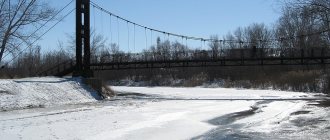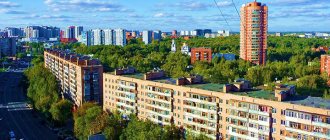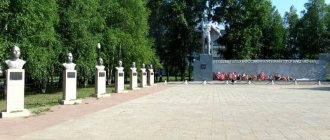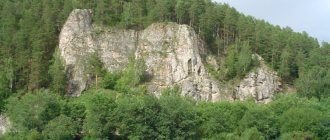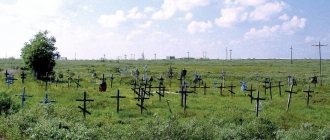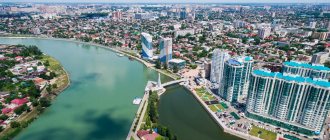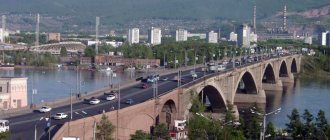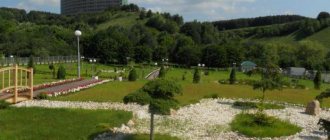Officially, the city of Berezniki in the Perm Territory (Volga Federal District) was formed less than a hundred years ago, in 1932, but settlements in its place have existed for a very long time.
The first chronicle mentions of them date back to 1570 (and archaeological excavations even indicate the presence of our ancestors on the Kama during the Iron Age).
Now it is the second largest city in the Perm Territory (after Perm itself, the distance to which is 160 km), having the status of a city of regional significance. From a metropolitan point of view, its population is not at all large - only 140,000 people - but the industrial significance of Berezniki for the country is enormous.
Settlements on the territory of modern Berezniki appeared thanks to potassium-magnesium salt deposits of the Permian period.
Back in the 16th–17th centuries, salt was produced there, and villages and villages spontaneously settled down in the vicinity of the saltworks. The turning point occurred in 1883, when the Perm merchant I. Lyubimov founded a soda factory here.
A factory village was founded, industry began to actively develop, and in 1932, by decree of the government of the RSFSR, the city of Usolye, together with the working villages of Veretiya, Dedyukhin, Lenva, Ust-Zyryanka and Churtan, were united into one city - Berezniki, which included the adjacent territories:
- village of Zyryanka;
- village Kamen;
- village of Basevo;
- a village created for agricultural workers.
From that moment on, the area began to be actively developed - educational institutions and new industries appeared - Berezniki became the center of the chemical industry, producing fertilizers for the whole country.
After the war, the city continued to develop in the same direction. To date, little remains of the ancient picturesque town - Berezniki looks more like a production center of the second half of the 20th century; the architecture bears the imprint of the 50s and 60s.
Modern ecologists believe that a city overloaded with industry is not yet an environmental disaster, but already an atmosphere in which it is unsafe to live.
This is also confirmed by sinkholes that have formed since 2007 in places where groundwater washed the walls of mines - as a result of their appearance, brines (solutions of potassium and magnesium salts) completely flooded several mines.
Interesting: the first “bells” of future accidents began back in 1986, when, during work at the third mine, brine leaks were discovered, which later turned into streams (the “Distant Relative” failure). Discussions about the need to fill mine voids have been going on since the late 80s, but so far “things are still there.”
Climate of Berezniki
The Russian north near the Ural Mountains is not the most weather-friendly place. Winter frosts down to -30 °C are not uncommon; snow lasts from October to April.
The climate is moderate continental, characterized by long, rather harsh winters and short, cool summers. The average temperature for the year is 0.9 °C, the average temperature in July (the warmest month) is 17 °C, in January (the coldest) - -14 °C.
Map
| Berezniki: maps |
Berezniki: photos from space (Google Maps) Berezniki: photos from space (Microsoft Virtual Earth)
| Berezniki. Nearest cities. Distances in km. on the map (in brackets along roads) + direction. Using the hyperlink in the distance , you can get the route (information courtesy of the AutoTransInfo website) | |||
| 1 | Usolye | 5 (9) | IN |
| 2 | Solikamsk | 24 (26) | WITH |
| 3 | Yaiva | 29 (27) | IN |
| 4 | Alexandrovsk | 53 (57) | SE |
| 5 | Kizel | 63 (71) | SE |
| 6 | Ugleuralsky | 70 () | SE |
| 7 | Gubakha | 77 (95) | SE |
| 8 | Chermoz | 79 (407) | SW |
| 9 | Dobryanka | 107 (129) | YU |
| 10 | Cherdyn | 110 (134) | WITH |
| 11 | Krasnovishersk | 110 (139) | WITH |
| 12 | Gremyachinsk | 112 (138) | SE |
| 13 | Ilyinsky | 113 (258) | SW |
| 14 | Yusva | 115 (400) | SW |
| 15 | Scythe | 116 (530) | NW |
a brief description of
The city is located in the Urals, 278 km north of Perm. The port is on the left bank of the Kama Reservoir (connected by a bridge to the town of Usolye). Railway station.
Territory (sq. km): 431
Information about the city of Berezniki on the Russian Wikipedia site
Historical sketch
The city is located on the richest deposits of potash, magnesium and table salt. On the site of the modern city in the 17th century. there were salt-making industries. In 1873, at the site of the fields, Perm industrialist I.I. Lyubimov built the Bereznikovsky salt plant, and in 1883 a soda plant (one of the first in Russia).
There was once an island off the left bank of the Kama, called Berezovy after the predominant vegetation. Over time, the channel separating the island became overgrown and a tract called Bereznik arose.
In 1929, the construction of the Berezniki chemical plant and the development of potassium salt deposits began in the tract. It was decided to unite the scattered workers' settlements that arose during construction into a city, for which the names Khimgrad, Khimstroy, Dzerzhinsk, Verkhnekamsk and Bereznyakovsk were proposed. By decree of the All-Russian Central Executive Committee of March 20, 1932, the city of Berezniki was formed from the city of Usolye-Solikamskoye (11.7 thousand inhabitants, 1931) and the working villages of Veretiya, Dedyukhino, Lenva, Ust-Zyryanka and Churtan. The city of Dedyukhin (founded in the 19th century, a city since 1805, a village since 1918, 3.3 thousand inhabitants - 1897, 4.7 thousand inhabitants, 1931), the village of Veretia (urban settlement from August 27, 1928, 2.5 thousand inhabitants. , 1931), the village of Lenva (PGT from 08/27/1928, 7.8 thousand inhabitants, 1931), the village of Ust-Zyryanka (PGT from 02/25/1929, 1.4 thousand inhabitants, 1931), Churtan (PGT from 08/27/1928, 4.7 thousand inhabitants, 1931).
On August 30, 1940, the city of Usolye was separated from the city of Berezniki.
Municipal indicators
| Index | 1999 | 2001 | 2003 | 2005 |
| Demography | ||||
| Number of births, per 1000 population | 8.4 | 9.1 | 10.5 | 10.5 |
| Number of deaths, per 1000 population | 14.7 | 15.8 | 17.2 | 17.8 |
| Natural increase (decrease), per 1000 population | -6.3 | -6.7 | -6.7 | -8.3 |
| Standard of living of the population and social sphere | ||||
| Average monthly nominal accrued wages, rub. | 2212 | 4045 | 5642 | 8542.4 |
| Average housing area per inhabitant (at the end of the year), sq.m. | 17.2 | 18.1 | 19.2 | 19.8 |
| Number of preschool institutions, pcs. | 76 | 73 | 69 | 69 |
| Number of children in preschool institutions, thousand people | 8.1 | 8 | 8.1 | 8.4 |
| Enrollment of children in preschool educational institutions (at the end of the year), as a percentage of the number of children of the corresponding age, % | 82.9 | 83.3 | ||
| Number of daytime educational institutions (at the beginning of the school year), pcs. | 34 | 34 | 31 | 30 |
| Number of students in daytime educational institutions, thousand people | 23.6 | 21.7 | 19.2 | 16.9 |
| Number of doctors, people. | 866 | 866 | 718 | 690 |
| Number of nursing staff, people. | 2511 | 2399 | 2100 | 1997 |
| Number of hospital institutions, pcs. | 7 | 7 | 7 | 7 |
| Number of hospital beds, thousand units | 2.3 | 2.2 | 2.1 | 1.6 |
| Number of medical outpatient clinics, pcs. | 15 | 9 | 9 | 9 |
| Capacity of medical outpatient clinics, visits per shift, thousand units. | 7.6 | 4.3 | 4.4 | 4.4 |
| Number of registered crimes, pcs. | 6021 | 6401 | 5742 | 10225 |
| Persons who committed crimes were identified, persons. | 2951 | 3039 | 2177 | 2509 |
| Economy, industry | ||||
| Number of enterprises and organizations (at the end of the year), pcs. | 1953 | 1908 | 2160 | 2470 |
| Number of operating enterprises by type of activity: mining (at the end of the year), pcs. | 5 | |||
| Number of operating enterprises by type of activity: manufacturing (at the end of the year), pcs. | 103 | |||
| Number of operating enterprises by type of activity production and distribution of electricity, gas and water (at the end of the year), pcs. | 28 | |||
| Volume of shipped goods of own production by type of mining (in actual prices), million rubles. | 1668.5 | |||
| Volume of shipped goods of own production by type of manufacturing (in actual prices), million rubles. | 31501.3 | |||
| Volume of shipped goods of own production by type of production and distribution of electricity, gas and water (in actual current prices), million rubles. | 845.1 | |||
| Construction | ||||
| Volume of work performed by type of activity “Construction” (until 2004 - volume of work performed under construction contracts), million rubles. | 597.8 | 1835 | 1223.3 | 1094.4 |
| Commissioning of residential buildings, thousand sq.m. of total area | 14.4 | 15.6 | 2.6 | 7.9 |
| Commissioning of residential buildings, apartments | 237 | 264 | 27 | 95 |
| Commissioning of preschool institutions, places | 0 | 0 | 0 | 0 |
| Commissioning of educational institutions, places | 0 | 0 | 0 | 0 |
| Commissioning of hospital facilities, beds | 0 | 0 | 0 | 0 |
| Commissioning of outpatient clinics, visits per shift | 0 | 0 | 0 | 0 |
| Transport | ||||
| Number of bus routes (in intracity traffic), pcs. | 16 | 30 | 34 | 30 |
| Number of tram routes, pcs. | 0 | 0 | ||
| Number of trolleybus routes, pcs. | 13 | 13 | ||
| Length of operational trolleybus lines (at the end of the year), km | 27.3 | 24.8 | ||
| Number of passengers transported by buses per year (in intracity traffic), million people. | 58.5 | 31.9 | 50.1 | 13.7 |
| Number of passengers transported by trams per year, million people. | 0 | |||
| Number of passengers transported by trolleybuses per year, million people. | 29.4 | 28.1 | 14.2 | |
| Connection | ||||
| Number of residential telephone sets of the city public telephone network, thousand units. | 35.1 | 36.9 | 44.6 | 48.3 |
| Number of payphones of the city telephone network (including universal ones), pcs. | 327 | 307 | ||
| Trade and services to the population | ||||
| Retail trade turnover (in actual prices), million rubles. | 2191.1 | 2712.9 | 3967.2 | 6151.4 |
| Retail trade turnover (in actual prices), per capita, rub. | 11902 | 14744 | 22774 | 36377 |
| Index of physical volume of retail trade turnover, % compared to the previous year | 101.9 | 129.8 | ||
| Public catering turnover (in actual prices), million rubles. | 215.2 | 295.4 | 305.1 | 411.2 |
| Index of physical volume of public catering turnover, % compared to the previous year | 84.9 | 110.9 | ||
| Number of stores, pavilions (at the end of the year), pcs. | 39 | 26 | ||
| Sales area of shops, pavilions (at the end of the year), sq.m. | 10800 | 13883 | ||
| Volume of paid services to the population (in actual prices), million rubles. | 227.2 | 870.8 | 1183.3 | 1721.8 |
| Volume of paid services to the population (in actual prices), per capita, rub. | 1234.3 | 4743.1 | 6792.6 | 10182.1 |
| Volume of household services to the population (in actual prices), million rubles. | 7.1 | 11.7 | 21.3 | 26.7 |
| Volume of household services to the population (in actual prices), per capita, rub. | 38.8 | 63.5 | 122.3 | 158 |
| Investments | ||||
| Investments in fixed assets (in actual prices), million rubles. | 1133.9 | 2054.8 | 2126.5 | 4927 |
| Share of investments in fixed assets financed from budgetary funds in the total volume of investments, % | 11.8 | 6.9 | 2.4 | 1.5 |
Data sources:
- Regions of Russia. Main characteristics of the constituent entities of the Russian Federation: statistical collection. Goskomstat of Russia. - M:, 2003.
- Regions of Russia. Volume 1. Statistical collection. Goskomstat of Russia. - M:, 2001. p. 371
- Regions of Russia. Basic socio-economic indicators of cities. Statistical collection. Rosstat. - M:, 2005. p. 243
- Transport in Russia: Statistical collection. Goskomstat. - M:, 2003. pp. 112, 122
- Transport in Russia: Statistical collection. Rosstat. - M:, 2005. pp. 119, 129
- Regions of Russia. Basic socio-economic indicators of cities. 2006. Statistical collection. Rosstat. - M:, 2006. p. 227
Economy
Berezniki is one of the centers of the Russian chemical industry.
JSC Uralkali (potassium fertilizers, technical salt), PA Soda, Azot (ammonia, ammonium and sodium nitrate, complex liquid fertilizers). JSC - "Avisma" (titanium sponge, metallic magnesium, etc.), "Beraton" (dyes, photochemical and paint products). Enterprises in the electrical, metalworking, construction materials, light and food industries.
In Berezniki: deposits of potassium, magnesium and table salts.
Main enterprises
NON-FERROUS METALLURGY
OJSC "AVISMA" Titanium-magnesium plant
618421, Perm region, Berezniki, st.
Zagorodnaya, 1 Offers:
high-purity magnesium, magnesium alloys, titanium sponge, protectors made of magnesium alloys
CHEMICAL INDUSTRY
OJSC "Soda"
618403, Perm region, Berezniki,
Offers:
soda ash, synthetic detergents, sodium, quicklime, furniture
OJSC "Uralkali"
618426, Perm region, Berezniki, st.
Pyatiletki, 63 Offers:
potassium-containing fertilizers, complex fertilizers, balneological salts, unique speleological chambers
Beraton LLC
618421, Perm region, Berezniki, st.
Bereznikovskaya, 202 Offers:
synthetic dyes, aniline, urea, burnt magnesia
Culture, science, education
Drama Theater.
Museum of Local Lore.
Universities of the city
Berezniki branch of Perm State Technical University
618404, Perm region, Berezniki, st. Telmana, 7 WWW: https://www.bf.pstu.ac.ru/
Berezniki branch of Perm State University
618426, Perm region, Berezniki, Yubileinaya st., 99
Ural State Economic University (Berezniki branch)
618400, Perm region, Berezniki, st. Lenina, 33
Museums, galleries, exhibition halls
Berezniki Historical and Art Museum named after. I.F. Konovalova 618400, Perm region, Berezniki, Lenin Ave., 43 Phone(s): (242) 6-48-79 Website: https://www.museum-berezniki.ru/
| Population by year (thousands of inhabitants) | |||||||
| 1926 | 19.7 | 1982 | 189 | 2005 | 169.9 | 2015 | 149.0 |
| 1939 | 64.6 | 1986 | 198 | 2006 | 168.3 | 2016 | 146.6 |
| 1959 | 106.1 | 1989 | 201.2 | 2007 | 167.0 | 2017 | 145.1 |
| 1962 | 120 | 1992 | 197.4 | 2008 | 166.0 | 2018 | 143.1 |
| 1967 | 134 | 1996 | 182.9 | 2010 | 164.1 | 2019 | 141.3 |
| 1970 | 145.6 | 1998 | 182.1 | 2011 | 156.5 | 2020 | 139.2 |
| 1973 | 154 | 2000 | 181.9 | 2012 | 154.6 | 2021 | 137.1 |
| 1976 | 174 | 2001 | 181.3 | 2013 | 153.0 | ||
| 1979 | 185.4 | 2003 | 173.1 | 2014 | 150.7 | ||
Population size and composition
In 1937, it was planned that from a population of 110,000 people, the population of Berezniki would grow to 250,000 by 1947, but the Great Patriotic War made its own adjustments.
Of the 65,000 Berezniki residents who lived in the city at the beginning of 1940, more than 8,000 did not return from the fronts - the city lost a large part of its working-age male population.
At the same time, the city of Berezniki became an evacuation center, receiving more than 30,000 civilians from the battlefields and many tons of equipment from closed enterprises (it was later used to make ammunition on the rear).
The next population census was carried out only in 1959, and according to its results, Berezniki became home to 106,000 citizens. The city experienced its demographic maximum in the late 80s, when its population numbered more than 200,000 people.
Nowadays young people prefer larger cities and often leave to study and work in regional and regional centers and capitals.
The basis of the population of Berezniki are people of retirement age and families of factory workers; Among able-bodied city residents, the majority are men, and among pensioners, women.
Perm is the regional capital
The largest city in the Perm region is home to people of dozens of nationalities. According to many Perm residents, public transport has become one of the main problems of the city. Many large companies are private, so they may not provide travel benefits. Of course, an exception is made for students, schoolchildren and the elderly. The lack of a metro makes the situation worse; people often suffer crushes. The lack of budgets does not allow the situation to be resolved.
Perm is a large city in terms of area; only million-plus cities can boast of a larger size. In this regard, the lack of an established infrastructure, the improvement of which will require huge amounts of money, is added to the list of its problems. The Dzerzhinsky district is considered one of the most favorable in terms of infrastructure. There are quite a lot of municipal schools, kindergartens, and a large university here. The Kirovsky district offers children's clinics and a hospital for adults. There are also several sports schools here. In the Motovilikha district there are hospitals, clinics, preschool institutions, colleges and schools. Perm trams have become significantly more convenient, with seats for the disabled. The city's road network has a well-thought-out layout. Public transport moves easily through its territory, but there is a lack of interchanges, especially highways, that could connect the suburbs. An increase in the number of cars leads to an increase in traffic intensity. There are many jobs offered to Perm residents. There is a large branch, industrial enterprises, a machine-building plant, a metallurgy plant, and a printing factory. Even people from the scientific field can find here relevant organizations engaged in the study and development of technologies in the field of mining. The large number of universities resulted in a high percentage of educated citizens among the local population.
Coat of arms, flag and anthem of the city
The coat of arms of Berezniki is a silver shield crossed diagonally by a blue ribbon-sash, symbolizing the Kama River, on which the city stands. Against the background of the bandage, three white equilateral crystals are depicted - this is sylvite (potassium chloride), a mineral that is rich in the Permian subsoil.
In the upper right corner there is a smaller version of the coat of arms of Perm - with a bear on a red background - as a sign that Berezniki belongs to the jurisdiction of the Perm region.
The city's flag depicts the same blue (azure) sash crossing a white background horizontally in the center. On it are the same three equilateral crystals of potassium salt.
It is curious that in the Berezniki anthem there is nothing about sinkholes, or even about mines in general. The city appears before the listener’s eyes, framed by greenery and beloved by the townspeople. Indeed, the forests around Berezniki are surprisingly dense, and the Kama River is beautiful and majestic even in cold weather, covered with ice.
Berezniki
(Perm region)
OKATO code:
57408
Founded:
1932
City since:
1932 City of regional subordination
Cities, population as of 01/1/2021
| Usolye | 6.1 |
| Telephone code (reference phone) | |
| 34242***** | 43-5-92 |
Deviation from Moscow time, hours:
2
Geographical latitude:
59°25′
Geographical longitude:
56°47′
Altitude above sea level, meters:
130 Sunrise and sunset times of the Sun and Moon in the city of Berezniki
Famous personalities
In his youth, Boris Yeltsin lived in Berezniki, whose father worked at Khimstroi - first as a foreman, and later as the head of the construction department (by the way, teachers testified that the future first president of Russia had problems with discipline, despite good grades).
Other famous Berezniki residents:
- director Stanislav Govorukhin;
- actor Georgy Burkov (he served in the local theater);
- poet and writer Alexey Reshetov, whose monument was mentioned above;
- Sambo champion Svetlana Burtseva;
- hockey players Sergei Zemchenok and Mikhail Mikhailov;
- swimming champion Vladimir Selkov;
- ballet dancer Sergei Tsvetkov;
- composer Vladimir Kobekin.
Berezniki has given the country many outstanding athletes (in particular, those currently performing in the international sports arena) and several medical dynasties. Most of the local politicians are also natives of the Perm region.
Interesting facts and stories
The discovery of sinkholes worried city residents and the administration and greatly affected everyday comfort - for example, in 2014 the station had to be closed because the railway tracks were in danger of collapse.
Since then, communication with Berezniki has been carried out only by road (it takes about 3 hours to drive from Perm). The post office does not always cope with the load, so many citizens prefer to use the services of SDEK and similar courier companies, which is not very convenient.
Despite the danger of sinkholes, city residents are accustomed to treating their appearance with humor and even giving them affectionate names. Thus, in Berezniki there are sinkholes bearing the popular names Malysh, Krokha, Kotya, Piglet (it opened fifth in a row) and Pancake (formed on Maslenitsa 2015).
Urban folklore is replete with legends. They are told more skeptically than seriously, but nevertheless they are passed on from mouth to mouth.
These are stories about the Mistress of the Potassium Mountain, who once appeared to the workers in the mine, about the special atmosphere of the Triangular Square, which was landscaped by V. Mindovsky, thereby improving the health of the place where the wounded were taken during war times.
There is also a kind of “conspiracy theory” - about nuclear reactors hidden by the state in the depths of the First Potash Mine. This is unlikely to be true, but it is undeniable that people who create a mysterious, fairy-tale information background around their hometown love their small homeland.
Berezniki is a developing city
The relatively large city shows an interesting population composition. It is dominated by elderly people. There is a regular outflow of young people; many are employed in the industrial sector. The most pressing problem for Berezniki was soil subsidence. Many people want to sell their apartments as soon as possible, but no one wants to take risks. Added to this problem is the poor state of the infrastructure. But thanks to the small number of cars, residents manage to avoid traffic jams.
No one will be surprised by the queues at kindergartens; the administration has to beg budgets from senior leaders in order to restore old schools and preschool institutions. Berezniki offers many higher education institutions. After them, the graduate will have a real opportunity to find a job. But not all specialties turn out to be relevant; however, even with an irrelevant specialty it is easier to get a job than without it. Employment is offered by small companies and firms. Harmful production, which is found everywhere in Berezniki, is compensated by the presence of gyms, health centers, and swimming pools. The city has two hospitals, which are located in different parts. Now Berezniki has received new medical equipment.
Reviews from residents and tourists
Galina, Gubakha
I don’t want to impose my opinion on anyone, but I’m one of those who didn’t like the Wagner monument. Indeed, the man who did so much for the entire Perm region could have been portrayed more representatively. And at the monument there was some cheerful fat man, you can see it even in the photo.
Ivan Anatolyevich, pos. Eagle
I wonder if there is some place to look down on the panorama of the city? The description of the failures is intriguing. I have been to Berezniki many times and heard a lot about them, but for some reason I paid almost no attention.
Igor, Kudymkar
I lived in Berezniki until the 2000s, this is my youth! There is a tree in the park that my father climbed as a child. A lot has changed now, but I still feel nostalgic when I come there. And I advise all Perm residents to go at least once, preferably in the summer.
How to find a plot on the public cadastral map of Berezniki
Information is presented by type of property. To find out publicly available information on a plot, you need to enter its cadastral number, location address, or click on the official map of Berezniki and the data will open for you:
- cadastral number;
- appointment;
- registered area;
- for the house, the year of construction;
- location coordinates.
By navigating a cadastral map from a satellite, you can assess the infrastructure surrounding the land plot, adjacent lands and objects.
To expand the list of information received about a land plot or building, here you can also order a report on the property or on the history of the transfer of rights, as well as a certificate of cadastral value.


